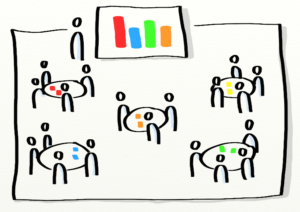 Large group retrospectives are long, large, unwieldy facilitations. So much so that they’re typically done only at the end of a project. Holding a 1-2 day retro every few weeks for a large project is neither practical nor responsible, but continually improving the project is also important. So, how do you hold light-weight retrospectives for large groups, while making sure that you:
Large group retrospectives are long, large, unwieldy facilitations. So much so that they’re typically done only at the end of a project. Holding a 1-2 day retro every few weeks for a large project is neither practical nor responsible, but continually improving the project is also important. So, how do you hold light-weight retrospectives for large groups, while making sure that you:
- Have a common understanding
- Identify issues and strengths
- Reach a group agreement on action points
- Ensure that the group feels that they received a high return on time invested
This retrospective combines different techniques and technologies to achieve these results.Continue reading

